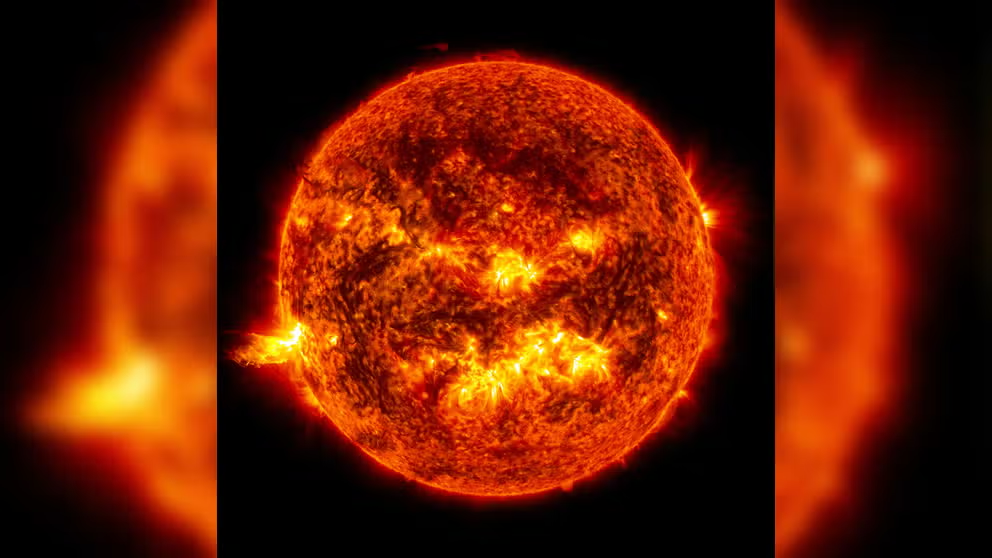What is a solar flare?
Solar flares are the largest explosions in the solar system. The energy released by one solar flare in one second is 10 million times more powerful than the energy released by a volcanic eruption, NASA said.
Space weather explained: What is a solar flare?
The largest explosions in the solar system, a solar flare is an explosion of energy that occurs on the sun’s surface, often appearing as a localized burst of bright light.
A solar flare is an explosion of energy that occurs on the sun’s surface, often appearing as a localized burst of bright light.
The explosion is the rapid release of magnetic energy that builds up in the sun’s atmosphere, according to NASA. That energy release emits radiation from virtually the entire electromagnetic spectrum.
How much energy flares release
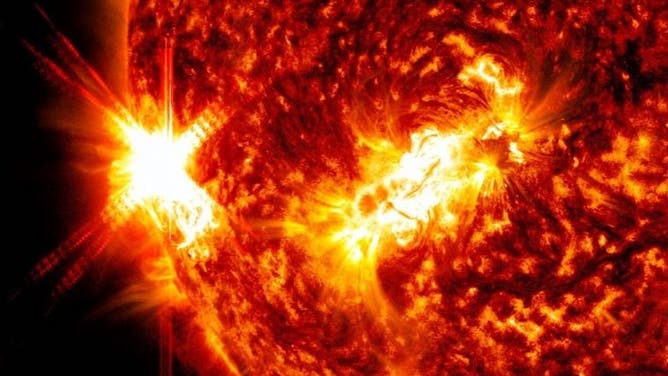
NASA’s Solar Dynamics Observatory captured this image of a solar flare – as seen in the bright flash on the left side of the image – on Jan. 9, 2023. The image shows a subset of extreme ultraviolet light that highlights the extremely hot material in flares and is colorized in red and gold.
(SDO / NASA)
Solar flares release a tremendous amount of energy.
The energy released by one solar flare in one second is 10 million times more powerful than the energy released by a volcanic eruption, NASA said. This amount of energy is also equal to that released by millions of 100-megaton hydrogen bombs exploding at the same time.
According to NASA, solar flares are our solar system’s largest explosive events. They also increase in frequency approximately every 11 years, following the solar cycle.
FLASHES OF LIGHT MAY HELP SCIENTISTS PREDICT WHEN SOLAR FLARS MAY EXPLODE FROM THE SUN
What causes solar flares

NASA's Solar Dynamics Observatory captured this image of a solar flare – as seen in the bright flash on the right side – on Sept. 10, 2017.
(SDO / Goddard / NASA)
Solar flares often occur near sunspots, which are dark parts of the surface of the sun. NASA said sunspots are darker because they are relatively cool compared to the rest of the sun’s surface, measuring about 6,500 degrees Fahrenheit.
In addition to being cooler, sunspots are also where magnetic fields are quite strong. They are so strong that they prevent heat inside the sun from reaching the surface, which is why sunspots have a lower surface temperature.
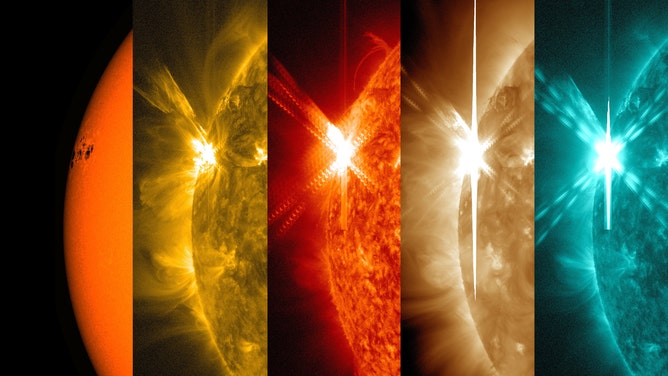
Images of a solar flare that show a different wavelength of extreme ultraviolet light, highlighting a different temperature of material on the sun. From left to right, the wavelengths are: visible light, 171 angstroms, 304 angstroms, 193 angstroms and 131 angstroms. Each wavelength has been colorized. May 5, 2015.
(NASA / SDO / Wiessinger / FOX Weather)
This nexus of magnetic fields is relevant to the topic of solar flares because, as the magnetic fields cross, tangle and reorganize, they can cause a large burst of energy – or, a solar flare.
Within a flare, NASA said the temperature may be 18 million or 36 million degrees Fahrenheit (10 million or 20 million degrees Kelvin), and can even reach as high as 180 million degrees Fahrenheit (100 million degrees Kelvin)
These high temperatures heat up particles, such as electrons, protons and heavy nuclei, according to NASA, which causes them to accelerate in the sun’s atmosphere.
Classes and stages of solar flares

NASA’s Solar Dynamics Observatory captured this image of a solar flare – as seen in the bright flash in the center-left– on Feb. 11, 2023.
(SDO / NASA)
Solar flares are classified based on their strength, NASA said, and fall into five categories designated by the letters A, B, C, M and X.
Each letter represents a 10-fold increase in energy output. This means that an X solar flare has 10 times the power of an M, while an M has 10 times the power of a C solar flare:
- X-class - The biggest flares, and the largest explosions in the solar system. According to NASA, the biggest X-class flares can produce as much energy as 1 billion atomic bombs.
- M-class - These are the second-strongest flares. They can cause polar radio blackouts on Earth, in addition to minor radiation storms that may be harmful to astronauts.
- C-class - These, along with B-class and A-class flares, are too weak to affect Earth.
- B-class - The second-smallest class of solar flares.
- A-class - The smallest solar flares and "near background levels," NASA said.
Within each class is a smaller scale running from 1 to 9. For example, a solar flare on Feb. 11, 2023, was classified as an X1.1 flare.
How scientists measure solar flares
NASA gives this short narrated video about solar flares, how they are classified, and their effect on Earth. (Video courtesy: NASA)
X MARKS THE (SUN)SPOT: HOW NASA RATES THE STRENGTH OF SOLAR FLARES
However, flares within the X-class can be ranked much higher. In 2003, the Halloween Storms produced the most powerful flare on record, overloading sensors that max out at X28.
Solar flares occur in three stages, according to NASA. Each stage emits different types of radiation and can last from a few seconds to an hour:
- The precursor stage - During this first stage, the release of magnetic energy is triggered. Soft x-rays are emitted at this time.
- The impulsive stage - Protons and electrons are accelerated to energies beyond 1 million electron volts (MeV). Radio waves, hard x-rays and gamma rays are emitted during this stage.
- The decay stage - In this last stage, soft x-rays gradually build up and decay.
This radiation then travels through space and can reach Earth.
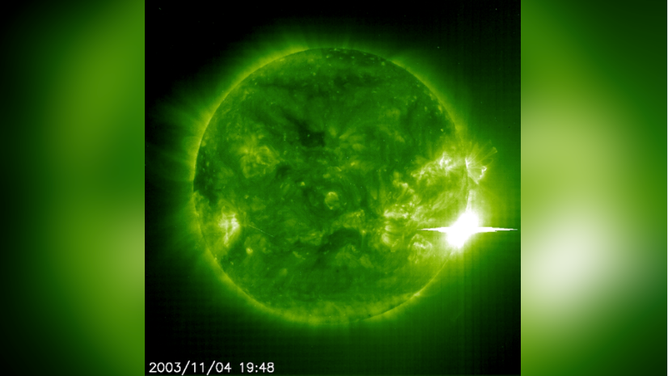
The X28 flare recorded on November 4, 2003.
(ESA & NASA / SOHO / NASA)
Impacts of solar flares on Earth
Scientists track solar flares for a number of reasons, NASA said.
For example, tracking flares allows us to gauge how radiation from solar flares can disrupt long-distance radio signals, damage satellites and other instruments in space and potentially harm astronauts.
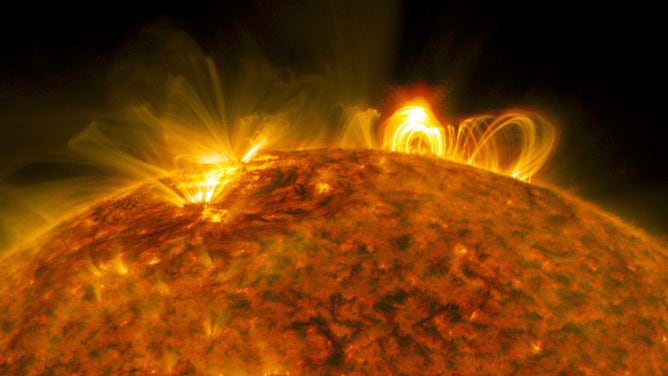
An X8.2 class solar flare flashes in the edge of the Sun on Sept. 10, 2017.
(GSFC / SDO / NASA)
On a more positive note, it helps us inform the forecast of the Northern Lights.
7 THINGS TO KNOW ABOUT NORTHERN LIGHTS
What is an aurora? The northern lights explained
Dancing across the skies in vibrant ribbons of color, auroras are one of nature’s most magnificent natural phenomena.
Solar flares can also help scientists understand similar energy release processes outside our solar system. Studying phenomena on our own sun can help provide information about phenomena, such as pulsars, black holes and quasars.
Studying solar flares, NASA noted, can also further research dedicated to achieving controlled thermonuclear fusion. The power source at the core of the sun, thermonuclear fusion, may be successfully implemented in a controlled environment and become a source of power on Earth.

